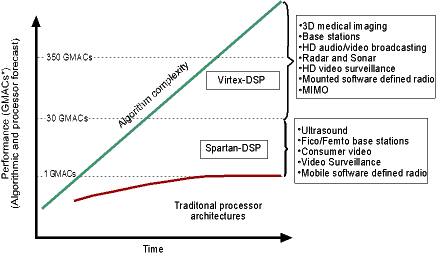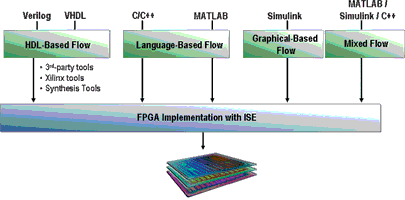
It is no accident that Xilinx FPGAs serve an increasingly vital role in the design and development of today’s most demanding digital signal processing (DSP) systems.
After two decades of research, engineering and close collaboration with hundreds of DSP customers, Xilinx FPGAs have evolved into highly valued DSP solutions platforms that deliver the extreme in performance, flexibility, time to market, and product longevity while reducing overall system costs and power consumption.
Long renowned for their ability to implement highly parallel architectures capable of performing complex algorithms in a single clock cycle, today's FPGAs can deliver literally hundreds of mega-samples per second (MSPS) and billions of multiply-accumulate operations per second (GMACS) with a single device. At these DSP performance levels, the designer can choose either to lower the clock rate of the FPGA to save power or to implement more channels to lower system cost and reduce the bill of materials (BOM).
Though certainly compelling, such cost/performance advantages mask other values - flexibility, time to market, and product longevity - that for some promise and deliver equally compelling rewards. High-growth markets like the communications, multimedia, video and imaging (MVI), and defence industries - all of which depend heavily on high-performance DSP technologies - are in a constant state of flux. Changing standards, changing market demands, changing customer requirements, changing economies, and changing competitive landscapes create substantial business opportunities for companies that can keep pace through innovation and flexibility. For a growing number of system architects and DSP designers, the FPGA is the platform of choice.
XtremeDSP initiative
In November of 2000, Xilinx launched the XtremeDSP initiative to create and continuously evolve a portfolio of application-optimised DSP solutions for the high-performance DSP demands of the communications, MVI and defence industries.
The top-level deliverables include:
Continuously expanding portfolio of high-performance devices for DSP designs.
* Development boards and kits, reference designs and IP.
* Design and development tools for varied approaches to DSP system design.
* Complementary programmable logic, connectivity and embedded processing functions.
* Strategic industry and university partnerships for training and support.
Extreme performance and flexibility
Performance, system-level cost- and power-efficiency, faster time to market and flexibility are the hallmarks of FPGA-based DSP designs. Driven by the global demand for higher quality, higher bandwidth, and inexpensive wired and wireless communication of voice, computer, and video data, the number and complexity of new communications standards has grown exponentially. This is due in large part to the need for interoperability and data exchange across myriad layers of legacy and next-generation networks. Moreover, it is the growing demand for wireless delivery of new services that is truly driving today's standards frenzy.
For the dynamic markets served by high-performance DSP solutions, the flexibility of the FPGA equates to:
* Lower system costs resulting from deeper levels of integration.
* Faster time to market with leading-edge algorithmic solutions and standards implementations, leading to substantially greater market shares.
* Easy-to-perform in situ remote adaptation to unforeseen environmental and functional changes (and therefore reduced operational costs).
* Extended life cycles for existing designs (and therefore reduced capital expenditures).
* The perfect platform for innovative product design and migration to keep pace with changing customer demands and market requirements.
XtremeDSP device portfolio
The XtremeDSP platform portfolio, comprised by the Virtex-DSP and Spartan-DSP series, provides the range of price, performance, power efficiency, bandwidth and IO to satisfy a broad spectrum of application requirements. The latest additions to the portfolio are the Virtex-5 SXT and the Spartan-3A DSP platforms.
Extreme performance and connectivity
The Virtex-5 SXT platform adds three new device options to the Xilinx XtremeDSP portfolio that meet the ultra-high DSP bandwidth and lower system-cost requirements of next-gen applications. Xilinx FPGAs now deliver DSP performance over 350 GMACS at 550 MHz while consuming 35% less dynamic power as compared to previous 90 nm generations. This platform is also the first DSP-optimised FPGA family to offer serial connectivity with low-power transceivers that operate up to 3,2 Gbps.
DSP platform - price/performance breakthrough
The search for the best DSP solution for a given application usually leads designers into a maze of price, performance, and power consumption trade-offs, often requiring a compromise of one or more to accommodate the others. With the introduction of Spartan-3A DSP platform, the first Spartan FPGA to be DSP optimised, the most efficient combination of these three critical values delivers the right mix for a host of applications.
* Signal-processing capacity:
The Spartan-3A DSP platform delivers over 30 GMACS and up to 2200 Gbps memory bandwidth at a volume price starting at under $301 in a small-footprint package. This represents a price/performance breakthrough that hits the mark for price and power-sensitive applications such as digital front-end (DFE) and baseband solutions in a single-channel pico-cell wireless base-station, military mobile software-defined radios (SDRs), ultrasound systems, driver assistance/media systems, HD video and smart IP cameras.
* DSP performance to the limit:
The accelerated growth of algorithmic complexity over the last two decades is among the more significant market dynamics driving the need for FPGAs in DSP applications. Fixed-architecture processors such as DSPs and general purpose processors are faced with inherent architectural inefficiencies that constrain their performance.
In addition, due in large part to the demand for communications systems that push the limits of data transmission towards that defined by Shannon's Law, advanced techniques such as Reed-Solomon codes and more recently, Turbo codes, have come much closer to reaching their theoretical limit, but at a cost of high computational complexity.
This leaves an ever-widening gap between today's algorithmic performance requirements and processor performance (Figure 1). As a result, designers must consider extending their design repertoire beyond fixed architecture processors to include the FPGA. FPGAs are well-suited to fill the performance gap because they offer extremely high-performance signal processing made possible by their parallelism. FPGAs also minimise risks due to changing standards, specifications and even environmental conditions by enabling design migration through their flexible architecture.

* DSP48E Slice:
One of the invaluable resources in every member of the XtremeDSP portfolio - and the one that contributes to both its raw performance and efficiency - is the DSP48 slice. The DSP48 slice is an application specific modular block (ASMBL) that powers the DSP functions in Virtex-DSP and Spartan-DSP devices. These help DSP designers implement solutions to complex challenges, ie, hundreds of IF-to-baseband down-conversion channels, 128X chip-rate processing for 3G spreadspectrum systems, high-definition H.264 and MPEG-4 encode/decode algorithms.
XtremeDSP design tools
The XtremeDSP initiative also gave light to a corporate commitment shared by Xilinx and its third-party ecosystem to make all of that DSP horsepower and flexibility accessible to three distinct designer profiles: the system designer, the DSP engineer, and the FPGA/hardware engineer. Each profile represents a unique set of responsibilities (and preferences) that dictate the requirements for their particular design environment (Figure 2).

Conclusion
FPGAs fill the substantial and growing gap between what is needed and what is available from traditional processors. While there are many reasons to employ FPGA-based DSP solutions, the four fundamental reasons are summarised as follows:
1. Handle very high computational workloads - FPGAs allow engineers to build highly parallel architectures, thereby allowing the sample rate to equal the clock rate.
2. Offload compute-intensive tasks from the DSP processor and save valuable cycles for implementing other functions.
3. Customise an architecture to suit the algorithm - FPGAs offer an array of MACs or multipliers to implement single or multitap architectures. The reconfigurable nature eases architecture construction and refinement.
4. Reduce system cost and power - FPGAs enable integration of other components (eg, Serial RapidIO transceivers, PCI Express interfaces, glue logic and low-rate control tasks), thereby reducing the overall system cost and power consumption. In addition, parallelism allows higher performance at lower frequencies, cutting power dramatically.
Since its inception, the Xilinx XtremeDSP initiative has generated a portfolio of application-optimised DSP solutions that combine specialised hardware platforms, design tools, reference designs, system-level application knowledge, software algorithms, and IP libraries. These solutions take high-performance DSP design to the extreme for communications, MVI and defence applications.

© Technews Publishing (Pty) Ltd | All Rights Reserved